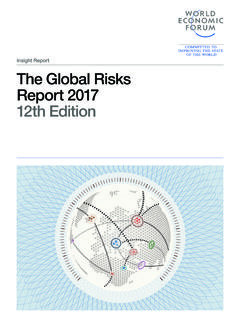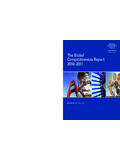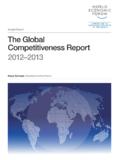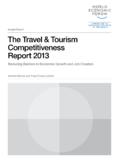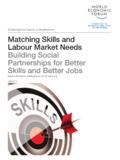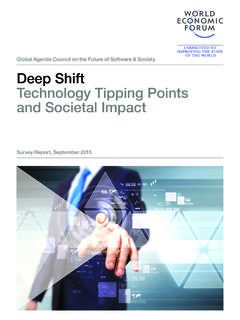Transcription of The Global Gender Gap Report 2008 - World Economic Forum
1 The Global Gender Gap Report 2008. Ricardo Hausmann, Harvard University Laura D. Tyson, University of California, Berkeley Saadia Zahidi, World Economic Forum World Economic Forum Geneva, Switzerland 2008. The Global Gender Gap Report 2008. Ricardo Hausmann, Harvard University Laura D. Tyson, University of California, Berkeley Saadia Zahidi, World Economic Forum The Global Gender Gap Report 2008 is World Economic Forum published by the World Economic Forum . 91-93 route de la Capite The Gender Gap Index 2008 is the result of CH-1223 Cologny/Geneva collaboration with faculty at Harvard University Switzerland and University of California, Berkeley. Tel.: +41 (0)22 869 1212. Fax: +41 (0)22 786 2744. E-mail: AT THE World Economic Forum Professor Klaus Schwab 2008 World Economic Forum Founder and Executive Chairman All rights reserved.
2 B rge Brende Managing Director No part of this publication may be reproduced or transmitted in any form or by any means, Fiona Paua including photocopying and recording, or by Head, Strategic Insight Teams any information storage and retrieval system. Saadia Zahidi Ref: 112006. Head of Constituents Tessema Tesfachew ISBN-10: 92-95044-09-6. Research Associate and Community Relations ISBN-13: 978-92-95044-09-8. Manager AT HARVARD UNIVERSITY. Professor Ricardo Hausmann Director, Center for International Development AT UNIVERSITY OF CALIFORNIA, BERKELEY. Professor Laura D. Tyson Professor of Business Administration and Economics Thank you to Hope Steele for her superb copyediting work and Ha Nguyen for her excellent graphic design and layout. We are very grateful to Kamal Kamaoui and the World Economic Forum 's Publications team for their invaluable collaboration on the production of this Report .
3 The terms country and nation as used in this Report do not in all cases refer to a territorial entity that is a state as understood by international law and practice. The term covers well-defined, geographically self-contained Economic areas that may not be states but for which statistical data are maintained on a separate and independent basis. Contents by Klaus Schwab PART 1: MEASURING THE Global Gender GAP 1. The Global Gender Gap Index by Ricardo Hausmann, Harvard University Laura D. Tyson, University of California, Berkeley Saadia Zahidi, World Economic Forum Appendix A: A Historical Perspective ..26. Appendix B: Regional Classifications ..29. PART 2: COUNTRY PROFILES 31. List of Countries ..33. User's Guide: How Country Profiles by Tessema Tesfachew and Saadia Zahidi Country About the Authors ..169. Preface KLAUS SCHWAB.
4 Founder and Executive Chairman, World Economic Forum In the midst of the current Economic downturn, policy- and opportunities linked to the Global Gender gap in busi- makers and business leaders are struggling to manage ness, education, politics and health; exchange best practices short-term shocks, prepare their economies to perform and collectively construct creative and viable strategies to well in a medium-term Economic landscape characterized optimize the use of data in this Report serve as by growing volatility and develop institutions and regula- a framework for the efforts of these communities. tions to stave off such crises in the future. It is more We would like to express our deep appreciation to important now than ever before for countries and compa- Ricardo Hausmann, Director, Center for International nies to pay heed to one of the fundamental cornerstones Development, Harvard University; Laura , of Economic growth available to them the skills and tal- Professor of Business Administration and Economics, ent of their human resource pool.
5 University of California, Berkeley, USA; and Saadia Women not only make up one half of this potential Zahidi, Head of Constituents, for their invaluable contri- talent base, they also contribute to bringing in some dif- bution to this Report . We would like to thank B rge ferent perspectives that are so important in a complex, Brende, Managing Director and Fiona Paua, Head, inter-dependent and fast-moving World . Over the past few Strategic Insight Teams and Senior Adviser to the decades, both developed and developing countries have Executive Chairman for their leadership of the Gender made substantial progress in educating women and Gap project at the World Economic Forum . improving their health. In many developed countries, We hope that this Report will lead to greater aware- women now account for more than half of the college and ness of the challenges and opportunities, in addition to university graduates, and many developing countries have serving as a catalyst for change in both high- and low- dramatically reduced Gender gaps in literacy and in pri- ranking countries, by revealing those countries that, within mary and secondary even in developed their region or their income group, are leaders in having countries, whose dependence on knowledge industries and divided resources equitably between women and men, knowledge workers is large and growing.
6 There are still sig- regardless of the overall level of resources also nificant gaps in the job opportunities for women and in hope that the Index will serve as a useful tool for policy- the wages paid to women compared with their male makers as they define their national priorities by providing counterparts; these gaps are even larger in most developing them with an understanding of their relative strengths and countries. weakness over time and a mechanism for international Innovation requires new, unique ideas and the best comparisons. ideas flourish in a diverse environment. More than ever, in the current Economic downturn we will need the best minds and the best leadership to find the most creative solutions, revive growth and prevent such crises in the future. In other words, we will need to ensure that the minds and talents of both women and men are fully engaged in this process.
7 Through the Global Gender Gap Reports, for the past three years the World Economic Forum has been provid- ing a framework for quantifying the magnitude of Gender - based disparities, tracking their progress over time and designing effective measures reducing them. In addition, in 2008, we have launched our Global Gender Parity Group and Regional Gender Parity Groups in Latin America, the Middle East, Africa and multi-stakeholder communities of highly influential leaders 50% women and 50% men from business, politics, academia, media and civil society seek to examine the specific challenges Global Gender Gap Report 2008 Measuring the Global Gender Gap v Part 1. Measuring the Global Gender Gap The Gender Gap Index 2008. RICARDO HAUSMANN, Harvard University LAURA D. TYSON, University of California, Berkeley SAADIA ZAHIDI, World Economic Forum Although Gender -based inequalities exist in the majority are briefly outlined below.
8 For a description of how these of the World 's cultures, religions, nations and income concepts are captured by the construction techniques used groups, there are differences in the way these disparities in the creation of the Index, please see the section below manifest themselves and how they evolve over on the Construction of the Index. Global Gender Gap Index,1 introduced by the World Economic Forum in 2006, is a framework for capturing Gaps vs. levels the magnitude and scope of these disparities and tracking The Index is designed to measure Gender -based gaps in their Index benchmarks national Gender gaps access to resources and opportunities in individual coun- on Economic , political, education- and health-based crite- tries rather than the actual levels of the available resources ria, and provides country rankings that allow for effective and opportunities in those do this in order comparisons across regions and income groups, and over to make the Global Gender Gap Index independent of the time.
9 First, the rankings are designed to create greater level of development. In other words, the Index is con- awareness among a Global audience of the challenges structed to rank countries on their Gender gaps not on posed by Gender gaps and the opportunities created by their development level. Rich countries have more educa- reducing them. Second, the straightforward methodology tion and health opportunities for all members of society and quantitative analysis behind the rankings are intended and measures of levels thus mainly reflect this well-known to serve as a base for designing effective measures for fact, although it is quite independent of the Gender -related reducing Gender gaps. issues faced by each country at its own level of income. The first part of this chapter reviews the underlying The Global Gender Gap Index, however, rewards coun- concepts employed in creating the Global Gender Gap tries for smaller gaps in access to these resources, regardless Index and outlines the methods used to calculate the of the overall level of resources.
10 For example, the Index second part of this chapter presents the 2008 penalizes or rewards countries based on the size of the gap rankings, Global patterns and regional performances and between male and female enrolment rates, but not for the calls attention to notable country Country overall levels of education in the country. Profiles contained in Part 2 of this Report give a more detailed picture of the relative strengths and weaknesses of Outcomes vs. means each country's performance compared with that of other The second basic concept underlying the Global Gender nations. Each profile contains detailed information on over Gap Index is that it evaluates countries based on outcome 30 Gender -related variables, presenting both the original variables rather than input measures. Our aim is to provide data used to create the Index and other variables that a snapshot of where men and women stand with regard to reflect some of the legal and social factors that affect some fundamental outcome variables related to basic Gender disparity in each country.
